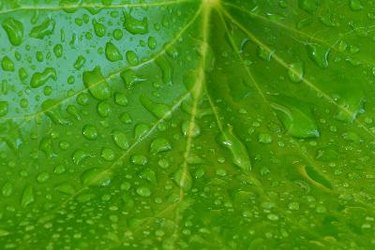
Glucose is a simple six-carbon sugar. Plants synthesize glucose from carbon dioxide and water as an end product of photosynthesis, the process that harnesses sunlight for the plant to use as energy. The central series of chemical reactions involved is called the Calvin-Benson cycle. It produces three-carbon sugars called glyceraldehyde 3-phosphate or G3P, which are in turn used to synthesize glucose.
Inputs to the Calvin Cycle
Video of the Day
The plants use sunlight to make an electron-carrier molecule called nicotinamide adenine dinucleotide phosphate (NADPH) and another molecule called adenosine triphosphate (ATP). ATP and NADPH provide energy for the Calvin cycle. The other major component for the Calvin cycle is carbon dioxide, which the plant adds to a five-carbon sugar named ribulose biphosphate (RuBP). The enzyme that attaches carbon dioxide to RuBP is called rubisco.
Video of the Day
Steps in the Calvin Cycle
Adding CO2 to RuBP creates an unstable six-carbon sugar that immediately breaks down into two 3-phosphoglycerate molecules. Molecules of ATP donate phosphate groups to make 3-phosphoglycerate into 1,3-biphosphoglycerate. Next, molecules of NADPH donate electrons to reduce 1,3-biphosphoglycerate to an aldehyde called glyceraldehyde-3-phosphate or G3P.
One of every six molecules of G3P produced is spun off, while the remainder are used to regenerate RuBP. G3P is a starting point for the synthesis of many other molecules, including glucose.
To Glucose and Beyond
With the aid of an enzyme called an aldolase, two molecules of G3P are used to make a six-carbon sugar called fructose-1,6-biphosphate, which is in turn converted to fructose-6-phosphate with the loss of a phosphate group. An enzyme called hexose phosphate isomerase converts fructose-6-phosphate to glucose-1-phosphate, which can be further altered, depending on whether it will be used to make sucrose or starch. Starch can be manufactured inside the chloroplast, while sucrose (also called table sugar) is produced in the cytosol of the cell.
Importance
Sucrose is a disaccharide, or two-sugar compound, made by joining a molecule of fructose and a molecule of glucose. Glucose and fructose are structural isomers, meaning that they both have the same molecular formula, but the atoms are connected differently. Sucrose can be transported throughout the plant to feed cells that do not photosynthesize; these same sugars can provide energy for humans and other animals as well. Starches are polymers of glucose molecules used by plants to store energy -- in the formation of seeds or tubers like potatoes, for example.